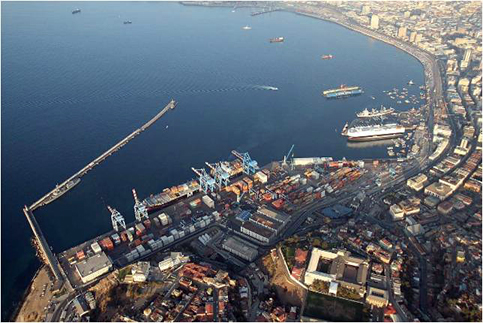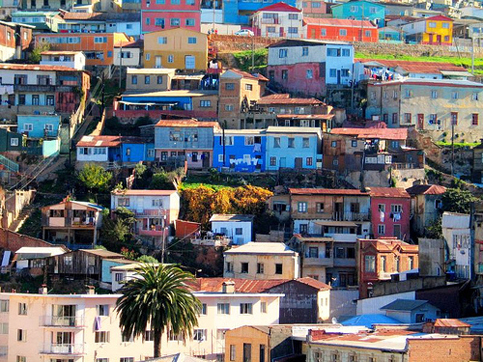Geographical Location and Population
Located on central Chile’s Pacific coast, the Historic Quarter of the Seaport City of Valparaíso represents an extraordinary example of industrial-age heritage associated with the international sea trade of the late 19th and early 20th centuries. The city was the first and most important merchant port on the sea routes of the Pacific coast of South America that linked the Atlantic and Pacific oceans via the Strait of Magellan. It had a major commercial impact on its region from the 1880s until the opening of the Panama Canal in 1914. After this date its development slowed, allowing its harbour and distinctive urban fabric to survive as an exceptional testimony to the early phase of globalisation.
Valparaiso emerged to the nineteenth century as the most important port city of Chile, as an urban settlement displayed nationally and internationally with an inseparable mixture between the city, its hills, its people and its port.
Although technically only Chile’s 6th largest city, with an urban area population of 263,499 (275,982 in municipality, the Greater Valparaíso metropolitan area, including the neighboring cities of Viña del Mar, Concón, Quilpué and Villa Alemana, is the second largest in the country (803,683 inhabitants).
According to the 2002 census of the National Statistics Institute, the commune of Valparaíso spans an area of 401.6 km2 (155 sq mi) and has 275,982 inhabitants (135,217 men and 140,765 women). Of these, 275,141 (99.7%) lived in urban areas and 841 (0.3%) in rural areas. The population fell by 2.4% (6858 persons) between the 1992 and 2002 censuses.
History
Valparaíso's bay was probably first populated by Picunches Indians, who were dedicated to agriculture. Other accounts say that it was the Changos who were nomads dedicated to fishing, and traveling between Caldera and Concepcion. Spanish explorers arrived in 1536, aboard the Santiaguillo, a supply ship sent by Diego de Almagro, who is considered the first European explorer, or discoverer, of Chile. The Santiaguillo carried men and supplies for Almagro’s expedition, under the command of Juan de Saavedra, who named the town after his native village of Valparaíso de Arriba in Cuenca, Spain.
During Spanish colonial times, Valparaíso remained a small village, with only a few houses and a church. After Chile’s independence from Spain (1818), Valparaíso became the main harbour for the nascent Chilean navy, and opened to international trade, formerly limited to commerce with Spain and its other colonies.
Valparaíso soon became a desired stopover for ships rounding South America via the Strait of Magellan and Cape Horn. It gained particular importance supporting and supplying the California Gold Rush (1848–1858). In its role as a major seaport, Valparaíso received immigrants from many European countries, mainly from Britain, Germany, France, Switzerland and Italy. German, French, Italian and English were commonly spoken among its citizens, who founded and published newspapers in these languages.
Intangible Cultural Heritage
The historic quarter of the seaport city of Valparaíso was nominated UNESCO World Heritage Site in 2003, under the category of Cultural Heritage.
A site enrolled in the List of the World Heritage must have an exceptional universal value, count on authenticity and integrity, and must be protected. This implies an official and universal recognition, constituting a wealth for the humanity.
The buffer zone of the World Heritage Site account with a norm of protection established like Typical Zone and Zone of Historical Conservation, with important value to preserve and recognized in a instrument of effective territorial Planning, this is the Communal Regulating Plan of Valparaiso. It is possible to indicate that the area of the Wharf known like the peak corresponding to the area of the Port. Also this area is an integral part of the Zone of protection of the Site nomination







Follow ICCN